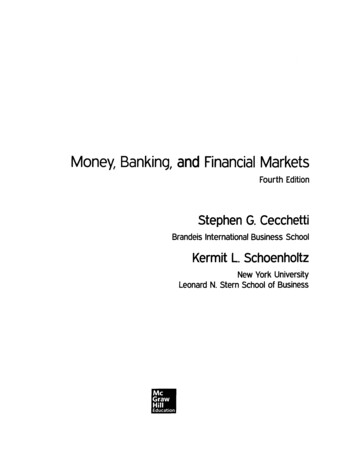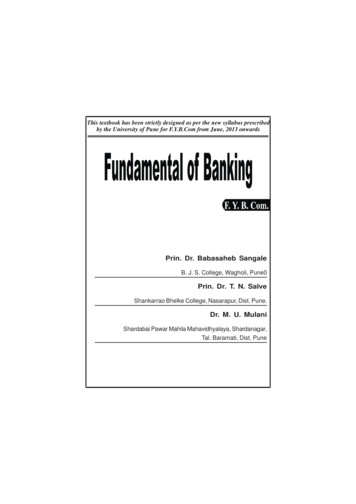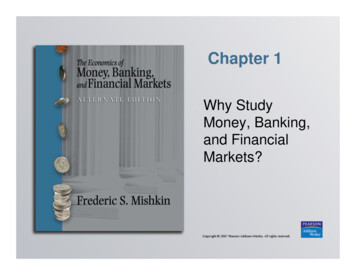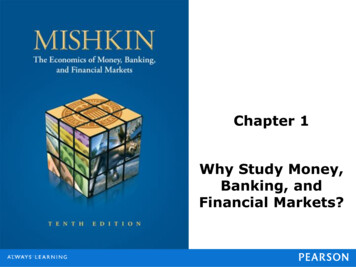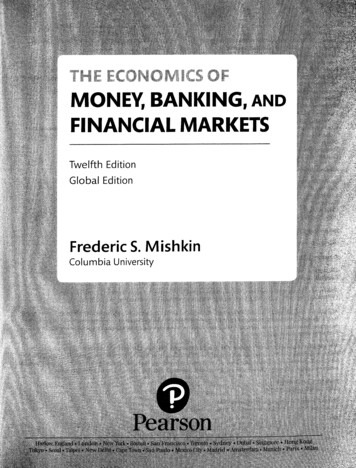
Transcription
1IMONEY, BANKING, ANDFINANCIAL MARKETSTwelfth EditionGlobal EditionFrederic S. MishkinColumbia Umversity PearsonDario«. Piudand 1 ortdon New Yoik Bnsfon Sau 1 raiu ist o Inrunlo S\ dno. Dubai Sinaapun1 I Ion# KonsTokyo voiü« rjijK-i New Dellu C/ipe Iowa Sao Paulo \lt\uo(ih Mathul Mnsteidaiii Miiuu.li l'u s Milan
Contents in Detailf0233ZBIntroduction51CHARTER 1Why Study Money, Banking, and Financial Markets?Why Study Financial Markets?Debt Markets and Interest RatesThe Stock MarketWhy Study Financial Institutions and Banking?Structure of the Financial SystemBanks and Other Financial InstitutionsFinancial InnovationFinancial CrisesWhy Study Money and Monetary Policy?Money and Business CyclesMoney and InflationMoney and Interest RatesConduct of Monetary PolicyFiscal Policy and Monetary PolicyWhy Study International Finance?The Foreign Exchange MarketThe International Financial SystemMoney, Banking, and Financial Markets and Your CareerHow We Will Study Money, Banking, and Financial MarketsExploring the WebConcluding 5Summary 65 Key Terms 66 Questions 66 Applied Problems 67 Data Analysis Problems 67 Web Exercises 68 Web References 68APPENDIX TO CHARTER 1Defining Aggregate Output, Income, the Price Level,and the Inflation Rate 69Aggregate Output and IncomeReal Versus Nominal MagnitudesAggregate Price LevelGrowth Rates and the Inflation Rate69697071CHARTER 2An Overview of the Financial System 72Function of Financial MarketsStructure of Financial Markets727511
12Contents in DetailDebt and Equity MarketsPrimary and Secondary MarketsExchanges and Over-the-Counter MarketsMoney and Capital MarketsFinancial Market InstrumentsMoney Market InstrumentsFollowing the Financial News Money Market Rates75757677777778Capital Market InstrumentsFollowing the Financial News Capital Market Interest Rates7980Internationalization of Financial Markets81Global Are U.S. Capital Markets Rösing Their Edge? 82International Bond Market, Eurobonds, and EurocurrenciesWorld Stock MarketsFunction of Financial Intermediaries: Indirect FinanceFollowing the Financial News Foreign Stock Market Indexes82838384Transaction Costs84Global The Importance of Financial Intermediaries Relative to Securities Markets:An International Comparison 85Risk SharingAsymmetrie Information: Adverse Selection and Moral HazardEconomies of Scope and Conflicts of InterestTypes of Financial IntermediariesDepository InstitutionsContractual Savings InstitutionsInvestment IntermediariesRegulation of the Financial SystemIncreasing Information Available to InvestorsEnsuring the Soundness of Financial IntermediariesFinancial Regulation Abroad8686888888909192929395Summary 95 Key Terms 96 Questions 96 Applied Problems 97 Data Analysis Problems 98 Web Exercises 98 « Web References 98CHARTER 3What Is Money? 99Meaning of MoneyFunctions of MoneyMedium of ExchangeUnit of AccountStore of ValueEvolution of the Payments SystemCommodity MoneyFiat Money99100100101102103103103
Contents in DetailChecksElectronic PaymentE-Money13103104104FYI Are We Headed for a Cashless Society? 105APPLICATION Will Bitcoin Become the Money of the Future?Measuring MoneyThe Federal Reserve's Monetary Aggregates105106106Following the Financial News The Monetary Aggregates 107FYI Where Are All the U.S. Dollars?108Summary 109 Key Terms 110 Questions 110 Applied Problems 111 Data AnalysisProblems 112 * Web Exercises 112 Web References 1120ZEEEBFinancial Markets113CHARTER 4The Meaning of Interest RatesMeasuring Interest RatesPresent Value114114114APPLICATION Simple Present Value116APPLICATION How Much Is That Jackpot Worth?Four Types of Credit Market InstrumentsYield to Maturity116117118APPLICATION Yield to Maturity on a Simple Loan:118APPLICATION Yield to Maturity and the Yearly Payment on a Fixed-Payment Loan. 120APPLICATION Yield to Maturity and Bond Price for a Coupon Bond121APPLICATION Yield to Maturity on a Perpetuity123APPLICATION Yield to Maturity on a Discount BondThe Distinction Between Interest Rates and Returns124125Global Negative Interest Rates? Japan First, Then the United States, Then Europe 126Maturity and the Volatility of Bond Returns: Interest-Rate RiskSummary128129The Distinction Between Real and Nominal Interest Rates130APPLICATION Calculating Real Interest Rates131Summary 133 « Key Terms 133 Questions 133 Applied Problems 134 * Data AnalysisProblems 135 Web Exercises 135 Web References 135CHARTER 4 APPENDIXMeasuring Interest-Rate Risk: DurationGo to MyLab Economics: www.pearson.com/mylab/economics
14Contents in DetailCHARTER 5The Behavi or of I nterest Rates136Determinants of Asset DemandWealthExpected ReturnsRiskLiquidityTheory of Portfolio ChoiceSupply and Demand in the Bond MarketDemand CurveSupply CurveMarket EquilibriumSupply and Demand AnalysisChanges in Equilibrium Interest RatesShifts in the Demand for BondsShifts in the Supply of LICATION Changes in the Interest Rate Due to a Change inExpected Inflation: The Fisher Effect148APPLICATION Changes in the Interest Rate Due to a Business Cycle Expansion. 150APPLICATION Explaining Current Low Interest Rates in Europe, Japan,and the United States: Low Inflation and Secular StagnationSupply and Demand in the Market for Money:The Liquidity Preference FrameworkChanges in Equilibrium Interest Rates in the Liquidity Preference FrameworkShifts in the Demand for MoneyShifts in the Supply of Money152155155155APPLICATION Changes in the Equilibrium Interest Rate Due toChanges in Income, the Price Level, or the Money SupplyChanges in IncomeChanges in the Price LevelChanges in the Money SupplyMoney and Interest Rates156157157157158APPLICATION Does a Higher Rate of Growth of the Money SupplyLower Interest Rates?160151Summary 163 « Key Terms 163 Questions 163 Applied Problems 164 Data Analysis Problems 165 Web Exercises 166 Web References 166CHARTER 5 APPENDIX 1Models of Asset PricingGoto MyLab Economics, www.pearson.com/mylab/economicsCHARTER 5 APPENDIX 2Applying the Asset Market Approach to a Commodity Market: The Case of GoldGoto MyLab Economics, www.pearson.com/mylab/economics
Contents in DetailCHARTER 5 APPENDIX 3Loanable Funds FrameworkGo to MyLab Economics, www.pearson.com/mylab/economicsCHARTER 6The Risk and Term Structure of Interest RatesRisk Structure of Interest RatesDefault Risk167167167FYI Conflicts of Interest at Credit-Rating Agencies and the Global Financial Crisis 171APPLICATION The Global Financial Crisis and the Baa-Treasury Spread 172LiquidityIncome Tax ConsiderationsSummary172173174APPLICATION Effects of the Obama Tax Increase on Bond Interest Rates 174Term Structure of Interest Rates175Following the Financial News YieldCurves 175Expectations TheorySegmented Markets TheoryLiquidity Premram and Preferred Habitat TheoriesEvidence on the Term StructureFYI The Yield Curve as a Forecasting Tool for Inflation and the Business CycleSummaryAPPLICATION Interpreting Yield Curves, 1980-2017177180181184185185185Summary 187 Key Terms 187 Questions 187 Applied Problems 189 «Data Analysis Problems 189 Web Exercises 190 Web References 190CHARTER 7The Stock Market, the Theory of Rational Expectations,and the Efficient Market Hypothesis 191Computing the Price of Common StockThe One-Period Valuation ModelThe Generalized Dividend Valuation ModelThe Gordon Growth ModelHow the Market Sets Stock Prices191192193193194APPLICATION Monetary Policy and Stock Prices196APPLICATION The Global Financial Crisis and the Stock Market196The Theory of Rational ExpectationsFormal Statement of the TheoryRationale Behind the TheoryImplications of the TheoryThe Efficient Market Hypothesis: Rational Expectations in Financial Markets196198198199200
16Contents in DetailRationale Behind the HypothesisRandom-Walk Behavior of Stock Prices201202Global Should Foreign Exchange Rates Follow a Random Walk?203APPLICATION Practical Guide to Investing in the Stock MarketHow Valuable Are Reports Published by Investment Advisers?Should You Be Skeptical of Hot Tips?FYI Should You Hire an Ape as Your Investment Adviser?203203204205Do Stock Prices Always Rise When There Is Good News?Efficient Market Prescription for the InvestorWhy the Efficient Market Hypothesis Does Not ImplyThatFinancial Markets Are Efficient205205206APPLICATION What Do Stock Market Crashes Teil Us About the EfficientMarket Hypothesis and the Efficiency of Financial Markets?207Behavioral Finance207Summary 208 Key Terms 209 Questions 209 Applied Problems 210 Data Analysis Problems 211 Web Exercises 211 Web References 211CHARTER 7 APPENDIXEvidence on the Efficient Market HypothesisGoto MyLab Economics, www.pearson.com/mylab/economicsj'IISliFinancial Institutions213CHARTER 8An Economic Analysis of Financial Structure 214Basic Facts About Financial Structure Throughout the World214Transaction CostsHow Transaction Costs Influenae Financial StructureHow Financial Intermediaries Reduce Transaction CostsAsymmetrie Information: Adverse Selection and Moral HazardThe Lemons Problem: How Adverse Selection Influences Financial StructureLemons in the Stock and Bond MarketsTools to Help Solve Adverse Selection Problems217217218219219220220FYI The Enron Implosion 222How Moral Hazard Affects the Choice Between Debt and Equity ContractsMoral Hazard in Equity Contracts: The Principal-Agent ProblemTools to Help Solve the Principal-Agent ProblemHow Moral Hazard Influences Financial Structure in Debt MarketsTools to Help Solve Moral Hazard in Debt ContractsSummary225225226228228230APPLICATION Financial Development and Economic Growth231FYI The Tyranny of Collateral232
Contents in DetailAPPLICATION Is China a Counterexample to the Importanceof Financial Development?233Summary 234 Key Terms 235 Questions 235 Applied Problems 236 Data Analysis Problems 237 Web Exercises 237 Web References 237CHARTERSBanking and the Management of Financial Institutions 238The Bank Balance SheetLiabilitiesAssetsBasic BankingGeneral Principles of Bank ManagementLiquidity Management and the Role of ReservesAsset ManagementLiability ManagementCapital Adequacy Management238238241242245245248249250APPLICATION Strategies for Managing Bank Capital252APPLICATION How a Capital Crunch Caused a Credit Cranell Düring theGlobal Financial CrisisManaging Credit RiskScreening and MonitoringLong-Term Customer RelationshipsLoan CommitmentsCollateral and Compensating BalancesCredit RationingManaging Interest-Rate RiskGap and Duration Analysis253253254255256256256257258APPLICATION Strategies for Managing Interest-Rate RiskOff-Balance-Sheet ActivitiesLoan SalesGeneration of Fee IncomeTrading Activities and Risk Management Techniques259259260260260Global Barings, Daiwa, Sumitomo, Societe Generale, and JP Morgan Chase:Rogue Traders and the Principal-Agent Problem 261Summary 262 Key Terms 263 Questions 263 Applied Problems 264 Data Analysis Problems 265 Web Exercises 265 Web References 266CHAPTER 9 APPENDIX 1Duration Gap AnalysisGo to MyLab Economics, www.pearson.com/mylab/economicsCHAPTER 9 APPENDIX 2Measuring Bank PerformanceGo to MyLab Economics, www.pearson.com/mylab/economics
18Contents in DetailCHARTER 10Economic Analysisof Financial Regulation 267Asymmetrie Information as a Rationale for Financial RegulationGovernment Safety Net267267Global The Spread of Government Deposit Insurance Throughout the World:Is This a Good Thing? 269Drawbacks of the Government Safety NetTypes of Financial RegulationRestrictions on Asset HoldingsCapital Requirements270272272273Global Where Is the Basel Accord Heading After the Global Financial Crisis?274Prompt Corrective ActionFinancial Supervision: Chartering and ExaminationAssessment of Risk ManagementDisclosure RequirementsConsumer ProtectionRestrictions on CompetitionSummaryGlobal International Financial Regulation275275276277278278279280Summary 282 Key Terms 283 Questions 283 Applied Problems 284 *Data Analysis Problems 284 Web Exercises 285 Web References 285CHAPTER 10 APPENDIX 1The 1980s Banking and Savings and Loan CrisisGo to MyLab Economics, www.pearson.com/mylab/economicsCHAPTER 10 APPENDIX 2Banking Crises Throughout the WorldGoto MyLab Economics, www.pearson.com/mylab/economicsCHAPTER 11Banking Industry: Structure and Competition 286Historical Development of the Banking SystemMultiple Regulator/ AgenciesFinancial Innovation and the Growth of the "Shadow Banking System"Responses to Changes in Demand Conditions: Interest-Rate VolatilityResponses to Changes in Supply Conditions: Information TechnologySecuritization and the Shadow Banking SystemAvoidance of Existing Regulations286288289290291293295FYI Bruce Beut and the Money Market Mutual Fund Panic of 2008 296Financial Innovation and the Decline of Traditional Banking297
Contents in DetailStructure ofthe U.S. Commercial Banking IndustryRestrictions on BrandungResponse to Brandung RestrictionsBank Consolidation and Nationwide BankingThe Riegle-Neal Interstate Banking and Brandung Efficiency Act of 1994What Will the Structure of the U.S. Banking Industry Look Like in the Future?Global Comparison of Banking Structure in the United States and Abroad300302302303305305306Are Bank Consolidation and Nationwide Banking Good Things?Separation of Banking and Other Financial Service IndustriesErosion of Glass-SteagallThe Gramm-Leach-Bliley Financial Services Modernization Act of 1999:Repeal of Glass-SteagallImplications for Financial ConsolidationSeparation of Banking and Other Financial Services Industries Throughout the World306307307308308308FYI The Global Financial Crisis and the Demise of Large,Free-Standing Investment Banks 309Thrift Industry: Regulation and StructureSavings and Loan AssociationsMutual Savings BanksCredit UnionsInternational BankingEurodollar MarketGlobal Ironie Birth of the Eurodollar Market309310310310311311312Structure of U.S. Banking OverseasForeign Banks in the United States312. 313Summary 314 » Key Terms 315 * Questions 315 Data Analysis Problems 316 Web Exercises 317 » Web References 317CHARTER 12Financial Crises in Advanced Economies318Global The European Sovereign Debt Crisis 319What Is a Financial Crisis?Dynamics of Financial CrisesStage One: Initial PhaseStage Two: Banking CrisisStage Three: Debt Deflation319320320322324APPLICATION The Mother of All Financial Crises: The Great DepressionThe U.S. Stock Market CrashWorldwide Decline in Asset PricesBank FailuresEconomic Contraction and Debt DeflationThe Global Financial Crisis of 2007-2009Causes of the 2007-2009 Financial Crisis324324325326326327327FYI Collateralized Debt Obligations (CDOs) and Credit Default Swaps 328Effects of the 2007-2009 Financial Crisis329
20Contents in DetailInside the Fed Was the Fed to Blame for the Housing Price Bubble? 330Height of the 2007-2009 Financial CrisisGovernment Intervention and the RecoveryShort-Term Responses and Recovery334335335Global Latvia's Different and Controversial Response: Expansionary ContractionStabilizing the Global Financial System:Long-Term ResponsesGlobal Financial Regulatory FrameworkPolicy Areas at the National LevelFYI The Libor Scandal336337337337340Future Regulations and Policy Areas at the International LevelBilateral and Multilateral Supervisor/ CooperationCollective Supervisor/ CooperationCollectively Coordinated Macroeconomic Stability PlansSelf-Discipline340341341341341Summary 342 Key Terms 343 Questions 343 » Data Analysis Problems 344 Web Exercises 345CHARTER 13Financial Crises in Emerging Economies 346Dynamics of Financial Crises in Emerging Market EconomiesStage One: Initial PhaseStage Two: Currency CrisisStage Three: Full-Fledged Financial CrisisAPPLICATION Crisis in South Korea, 1997-1998Financial Liberalization and Globalization MismanagedPerversion of the Financial Liberalization and GlobalizationProcess: Chaebols and the South Korean CrisisStock Market Decline and Failure of Firms Increase UncertaintyAdverse Selection and Moral Hazard Problems Worsen, and the Economy ContractsCurrency Crisis EnsuesFinal Stage: Currency Crisis Triggers Full-Fledged Financial CrisisRecovery CommencesGlobal China and the "Noncrisis" in PLICATION The Argentine Financial Crisis, 2001-2002Severe Fiscal ImbalancesAdverse Selection and Moral Hazard Problems WorsenBank Panic BeginsCurrency Crisis EnsuesCurrency Crisis Triggers Full-Fledged Financial CrisisRecovery BeginsGlobal When an Advanced Economy Is Eike an Emerging Market Economy:The Icelandic Financial Crisis of 2008 364359359360360361361364
Contents In DetailPreventing Emerging Market Financial CrisesBeef Up Prudential Regulation and Supervision of BanksEncourage Disclosure and Market-Based DisciplineLimit Currency MismatchSequence Financial Liberalization365365365366366Summary 366 Key Terms 367 * Questions 367 Data Analysis Problems 367 Web References 368Central Banking and the Conduct of Monetary PolicyCHARTER 14Central Banks 370Origins Of The Central Banking SystemVariations in The Functions and Structuresof Central BanksThe European Central Bank, the Euro System, and theEuropean System of Central BanksGlobal Who Should Own Central Banks?Decision-making Bodies of the ECB369370371371372Global The Importance of the Bundesbank Within the ECB 376How Monetary Policy Is Conducted Within the ECBGlobal Are Non-Euro Central Banks Constrained by Membership In the EU?The Federal Reserve SystemComparing the ECB and the FedThe Bank of EnglandGlobal Brexit and the BoE 380Structureof Central Banks in Larger EconomiesStructure and Independence of Central Banksin Emerging Market EconomiesShould Central Banks Be IndependentThe Case for IndependenceThe Case Against IndependenceThe Trend Toward Greater mmary 386 Key Terms 386 Questions 387 Web Exercises 387CHARTER 15The Money Supply Process 388Three Players in the Money Supply Process388The Fed's Balance SheetLiabilitiesAssetsControl of the Monetary BaseFederal Reserve Open Market OperationsShifts from Deposits into Currency38838939039039139221
22Contents in DetailLoans to Financial InstitutionsOther Factors That Affect the Monetary BaseOverview of the Fed's Ability to Control the Monetary BaseMultiple Deposit Creation: A Simple ModelDeposit Creation: The Single BankDeposit Creation: The Banking SystemDeriving the Formula for Multiple Deposit CreationCritique of the Simple ModelFactors That Determine the Money SupplyChanges in the Nonborrowed Monetary Base, MBnChanges in Borrowed Reserves, BR, from the FedChanges in the Required Reserve Ratio, rrChanges in Excess ReservesChanges in Currency HoldingsOverview ofthe Money Supply ProcessThe Money MultiplierDeriving the Money MultiplierIntuition Behind the Money MultiplierMoney Supply Response to Changes in the 02403403405406APPLICATION Quantitative Easing and the Money Supply, 2007-2017407Summary 409 Key Terms 409 « Questions 409 Applied Problems 410 Data Analysis Problems 411 « Web Exercises 411 « Web References 412CHARTER 15 APPENDIX 1The Fed's Balance Sheet and the Monetary BaseGo to MyLab Economics, www.pearson.com/mylab/economicsCHAPTER15 APPENDIX 2The M2 Money MultiplierGo to MyLab Economics, www.pearson.com/mylab/economicsCHAPTER 15 APPENDIX 3Explainingthe Behavior ofthe Currency RatioGo to MyLab Economics, www.pearson.com/mylab/economicsCHAPTER 15 APPENDIX 4The Great Depression Bank Panics, 1930-1933, and the Money SupplyGo to MyLab Economics, www.pearson.com/mylab/economicsCHAPTER 16Tools of Monetary Policy 413The Market for Reserves and the Federal Funds RateDemand and Supply in the Market for ReservesHow Changes in the Tools of Monetary Policy Affect the Federal Funds Rate413414415
Contents in DetailAPPLICATION How the Federal Reserve's Operating ProceduresLimit Fluctuations in the Federal Funds RateConventional Monetary Policy ToolsOpen Market Operations419420421InsidetheFed A Day at the Trading Desk 422Discount Policy and the Lender of Last Resort423Inside the Fed Using Discount Policy to Prevent a Financial Panic 425Reserve RequirementsInterest on ReservesRelative Advantages of the Different ToolsNonconventional Monetary Policy Tools and Quantitative EasingLiquidity ProvisionLarge-Scale Asset PurchasesInside the Fed Fed Lending Facilities Düring the Global Financial Crisis426426427427428428429Quantitative Easing Versus Credit EasingForward GuidanceNegative Interest Rates on Banks' DepositsMonetary Policy Tools of the European Central BankOpen Market OperationsLending to BanksInterest on ReservesReserve Requirements430432433434434434435435Summary 435 Key Terms 436 Questions 436 * Applied Problems 437 Data Analysis Problems 438 Web Exercises 438 Web References 438CHARTER 17The Conduct of Monetary Policy: Strategy and Tactics 439The Price Stability Goal and the Nominal AnchorThe Role of a Nominal AnchorThe Time-Inconsistency ProblemOther Goals of Monetary PolicyHigh Employment and Output StabilityEconomic GrowthStability of Financial MarketsInterest-Rate StabilityStability in Foreign Exchange MarketsShould Price Stability Be the Primary Goal of Monetary Policy?Hierarchical Versus Dual MandatesPrice Stability as the Primary, Long-Run Goal of Monetary n Targeting,Inflation Targeting in New Zealand, Canada, and the United KingdomAdvantages of Inflation TargetingDisadvantages of Inflation Targeting444445447449
24Contents in DetailThe Evolution of the Federal Reserve's Monetary Policy StrategyThe Fed's "Just Do It" Monetary Policy StrategyThe Long Road to Inflation Targeting450450452Inside the Fed Ben Bernanke's Advocacy of Inflation Targeting 453Global The European Central Banks Monetary Policy Strategy 453Lessons for Monetary Policy Strategy from the Global Financial CrisisImplications for Inflation TargetingShould Central Banks Try to Stop Asset-Price Bubbles?Two Types of Asset-Price BubblesThe Debate Over Whether Central Banks Should Try to Pop BubblesTactics: Choosingthe Policy InstrumentCriteria for Choosing the Policy InstrumentTactics: The Taylor RuleInside the Fed The Fed's Use of the Taylor RuleInside the Fed FedWatchers454455456456457460462463466466Summary 467 Key Terms 467 Questions 468 Applied Problems 469 Data Analysis Problems 469 Web Exercises 470 Web References 471CHAPTER17 APPENDIX 1Monetary TargetingGo to MyLab Economics, www.pearson.com/mylab/economicsCHAPTER 17 APPENDIX 2A Brief History of Federal Reserve PolicymakingGo to MyLab Economics, www.pearson.com/mylab/economicsInternational Finance and Monetary PolicyCHAPTER 18The Foreign Exchange Market 474Foreign Exchange MarketFollowingthe Financial News Foreign Exchange Rates473474475What Are Foreign Exchange Rates?Why Are Exchange Rates Important?How Is Foreign Exchange Traded?Exchange Rates in the Long RunTheory of Purchasing Power Parity475475476477477APPLICATION Burgernomics: Big Macs and PPPFactors That Affect Exchange Rates in the Long RunExchange Rates in the Short Run: A Supply and Demand Analysis479481483
Contents in DetailSupply Curve for Domestic AssetsDemand Curve for Domestic AssetsEquilibrium in the Foreign Exchange MarketExplainingChanges in Exchange RatesShifts in the Demand for Domestic AssetsRecap: Factors That Change the Exchange Rate483483485485485488APPLICATION Effects of Oranges in Interest Rates on the EquilibriumExchange Rate490APPLICATION The Global Financial Crisis and the Dollar492APPLICATION Brexit and the British Pound493Summary 494 Key Terms 495 Questions 495 Applied Problems 496 Data Analysis Problems 496 Web Exercises 497 Web References 497APPENDIX TO CHAPTER18The Interest Parity Conditlon 498Comparing Expected Returns on Domestic and Foreign AssetsInterest Parity Condition498500CHAPTER 19The International Financial System 502Intervention in the Foreign Exchange MarketForeign Exchange Intervention and the Money Supply502502Inside the Fed A Day at the Federal Reserve Bank of New Yorks ForeignExchange Desk 503Unsterilized InterventionSterilized InterventionBalance of PaymentsCurrent AccountFinancial AccountGlobal Should We Worry About the Large U.S. Current Account Deficit?505506506507507508Exchange Rate Regimes in the International Financial SystemGold StandardThe Bretton Woods SystemHow a Fixed Exchange Rate Regime WorksSpeculative Attacks508509509510512APPLICATION The Foreign Exchange Crisis of September 1992The Policy Trilemma512514APPLICATION How Did China Accumulate 4 Trillion of International Reserves? .515Monetary Unions515Managed Float516Global Will the Euro Survive? 516
26Contents in DetailCapital ControlsControls on Capital OutflowsControls on Capital InflowsThe Role ofthe IMFShould the IMF Act as an International Lender of Last Resort?International Considerations and Monetary PolicyDirect Effects of the Foreign Exchange Market on Monetary PolicyExchange Rate ConsiderationsTo Peg or Not to Peg: Exchange-Rate Targeting as an Alternative MonetaryPolicy StrategyAdvantages of Exchange-Rate TargetingDisadvantages of Exchange-Rate TargetingWhen Is Exchange-Rate Targeting Desirable for Industrialized Countries?When Is Exchange-Rate Targeting Desirable for Emerging Market Countries?Currency obal Argentina's Currency Board 525Dollarization525Summary 526 Key Terms 527 Questions 527 Applied Problems 528 »Data Analysis Problems 529 Web Exercises 530 Web References 530 23301Monetary Theory531CHARTER 20Quantity Theory, Inflation, and the Demand for Money 532Quantity Theory of MoneyVelocity of Money and Equation of ExchangeFront the Equation of Exchange to the Quantity Theory of MoneyQuantity Theory and the Price LevelQuantity Theory and Inflation532532534535535APPLICATION Testing the Quantity Theory of MoneyBudget Deficits and InflationGovernment Budget ConstraintHyperinflation536538538540APPLICATION The Zimbabwean HyperinflationKeynesian Theories of Money DemandTransactions MotivePrecautionary MotiveSpeculative MotivePutting the Three Motives TogetherPortfolio Theories of Money DemandTheory of Portfolio Choice and Keynesian Liquidity PreferenceOther Factors That Affect the Demand for MoneySummary540541541541541541542543543544
Contents in DetailEmpirical Evidence for the Demand for Money544Interest Rates and Money Demand.544Stability of Money Demand.545Summary 546 Key Terms 546 Questions 546 Applied Problems 548 Data Analysis Problems 548 Web Exercises 549 Web References 549CHARTER 20 APPENDIX 1The Baumol-Tobin and Tobin Mean Variance Models of the Demand for MoneyGo to MyLab Economics, www.pearson.com/mylab/economicsCHARTER 20 APPENDIX 2Empirical Evidence on the Demand for MoneyGo to MyLab Economics, www.pearson.com/mylab/economicsCHARTER 21The IS Curve 550Planned Expenditure and Aggregate DemandThe Components of Aggregate DemandConsumption ExpenditureFYI Meaning of the Word Investment550551551552Planned Investment SpendingGovernment Purchases and TaxesNet ExportsGoods Market EquilibriumSolving for Goods Market EquilibriumDeriving the IS CurveUnderstandingthe IS CurveWhat the IS Curve Teils Us: IntuitionWhat the IS Curve Teils Us: Numerical ExampleWhy the Economy Heads Toward EquilibriumFactors that Shift the IS CurveChanges in Government CATION The Vietnam War Buildup, 1964—1969Changes in Taxes560561APPLICATION The Fiscal Stimulus Package of 2009Changes in Autonomous SpendingChanges in Financial FrictionsSummary of Factors That Shift the IS Curve562563565565Summary 565 Key Terms 565 Questions 566 Applied Problems 567 Data Analysis Problems 568 Web Exercises 569 Web References 56927
28Contents in DetailCHARTER 22The Monetary Policy and Aggregate Demand Curves 570The Federal Reserve and Monetary PolicyThe Monetary Policy CurveThe Taylor Principle: Why the Monetary Policy Curve Has an Upward SlopeShifts in the MP CurveMovements Along Versus Shifts in the MP Curve570571571573574APPLICATION Movement Along the MP Curve: The Rise in the FederalFunds Rate Target, 2004-2006574APPLICATION Shift in the MP Curve: Autonomous Monetary Easing atthe Onset of the Global Financial CrisisThe Aggregate Demand CurveDeriving the Aggregate Demand Curve GraphicallyFactors That Shift the Aggregate Demand Curve574575576576FYI Deriving the Aggregate Demand Curve Algebraically 576Summary 581 Key Terms 581 Questions 581 Applied Problems 582 Data Analysis Problems 583 Web Exercises 584 Web References 584CHARTER 23Aggregate Demand and Supply Analysis585Aggregate Demand585Followingthe Financial News Aggregate Output, Unemployment, and Inflation 586Deriving the Aggregate Demand CurveFactors That Shift the Aggregate Demand Curve586587FYI What Does Autonomous Mean? 588Aggregate SupplyLong-Run Aggregate Supply CurveShort-Run Aggregate Supply CurvePrice Stickiness and the Short-Run Aggregate Supply CurveShifts in the Aggregate Supply CurvesShifts in the Long-Run Aggregate Supply CurveShifts in the Short-Run Aggregate Supply CurveEquilibrium in Aggregate Demand and Supply AnalysisShort-Run EquilibriumHow the Short-Run Equilibrium Moves to the Long-Run Equilibrium over TimeSelf-Correcting MechanismChanges in Equilibrium: Aggregate Demand ION The Volcker Disinflation, 1980-1986602APPLICATION Negative Demand Shocks, 2001—2004.604
Contents in DetailChanges in Equilibrium: Aggregate Supply (Inflation) ShocksTemporary Supply Shocks604604APPLICATION Negative Supply Shocks, 1973—1975 and 1978-1980Permanent Supply Shocks and Real Business Cycle Theory607607APPLICATION Positive Supply Shocks, 1995-1999Conclusions610611APPLICATION Negative Supply and Demand Shocks and the 2007-2009Financial CrisisAD/AS Analysis of Foreign Bu
The International Financial System 63 Money, Banking, and Financial Markets and Your Career 64 How We Will Study Money, Banking, and Financial Markets 64 Exploring the Web 65 Concluding Remarks 65 Summary

